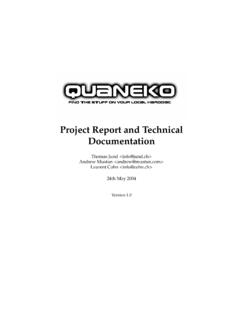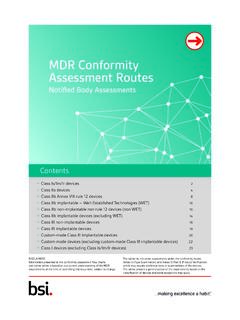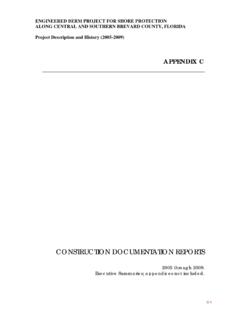Transcription of Draft Rehospitalization Technical Documentation - CMS
1 Home Health Claims-Based Rehospitalization Measures Preliminary Technical Specifications 1 METHODS. The home health Rehospitalization measures evaluate the outcomes of Rehospitalization and emergency department use without readmission for home health patients who were recently discharged from the hospital. These measures are titled Home Health Claims-Based Rehospitalization During the First 30 Days of Home Health and Home Health Claims-Based ED Use without Hospital Readmission During the First 30 Days of Home Health (referred to in the remainder of this report as Rehospitalization and ED use without hospital readmission, . respectively). These measures include home health stays beginning within 5 days of an inpatient hospital discharge and measure Rehospitalization or use of the ED without readmission during the 30 days following the beginning of home health care. Construction of Home Health Stays The home health Rehospitalization measures are calculated for each qualifying home health stay, where a home health stay is defined as a sequence of home health payment episodes separated from other home health payment episodes by at least 60 days.
2 Each home health payment episode is associated with a Medicare home health (HH) claim, so home health stays are constructed from claims data using the following steps: 1. First, retrieve HH claims with a from date during the 12-month observation period or the 120 days prior to the beginning of the observation period and sequence these claims by from date for each beneficiary. 2. Second, drop claims with the same from date and through date and claims listing no visits and no payment. Additionally, if multiple claims have the same from date, keep only the claim with the most recent process date. 3. Third, set Stay_Start_Date(1) equal to the from date on the beneficiary's first claim. Step through the claims sequentially to determine which claims begin new home health stays. If the claim from date is more than 60 days after the through date on the Home Health Claims-Based Rehospitalization Measures Preliminary Technical Specifications | Acumen, LLC 1.
3 Previous claim, then the claim begins a new stay. If the claim from date is within 60. days of the through date on the previous claim, then the claim continues the stay associated with the previous claim. 4. Fourth, for each stay, set Stay_Start_Date(n) equal to the from date of the first claim in the sequence of claims defining that stay. Set Stay_End_Date(n) equal to the through . date on the last claim in that stay. Confirm that Stay_Start_Date(n+1) minus Stay_End_Date(n) is greater than 60 days for all adjacent stays. 5. Finally, drop stays that begin before the 12-month observation window. Outcome Definition The home health Rehospitalization measures evaluate the outcomes of acute care Rehospitalization and ED use without readmission for home health patients who were recently discharged from the hospital. Observation stays that begin in a hospital emergency department will be captured in the ED use without hospital readmission measure.
4 Rehospitalization Measure The Rehospitalization measure numerator includes inpatient stays for patients who have a Medicare claim for an admission to an acute care hospital in the 30 days following the start of home health stay. The 30-day time window is calculated by adding 30 days to the from date in the first home health claim in the series of home health claims that comprise the HH stay. If the patient has at least one Medicare IP claim from short-term or critical access hospitals during the 30 day window, then the stay is included in the measure Because planned hospitalizations do not necessarily reflect the quality of home health care, inpatient claims for planned hospitalizations are excluded from the Rehospitalization measure numerator. Planned hospitalizations are defined using the same criteria as the Hospital- Wide All-Cause Unplanned Readmission (HWR) ED Use without Hospital Readmission Measure For the ED use without hospital readmission measure, the measure numerator includes inpatient stays for patients who have a Medicare claim for outpatient emergency use and no claims for acute care hospitalization in the 30 days following the start of the home health stay.
5 The 30-day time window is calculated by adding 30 days to the from date in the first HH claim in the series of HH claims that comprise the HH stay. If the patient has any Medicare outpatient 1. Short-term and critical access hospitals are identified by a CMS Certification Number ending in 0001-0879, 0800- 0899, or 1300-1399. 2. Details of the HWR measure may be found on the QualityNet page here: 2504318. 2 Acumen, LLC | Home Health Claims-Based Rehospitalization Measures Preliminary Technical Specifications claims with an ER revenue center code during the 30 day window and if the patient has no Medicare inpatient claims for admission to an acute care hospital during the 30 day window, then the stay is included in the measure There are no numerator exclusions for the ED. use without hospital readmission measure. Eligible Patient Population The Rehospitalization and ED use without hospital readmission measures evaluate the outcomes of Rehospitalization and emergency department use without readmission, respectively, for home health patients who were recently discharged from the hospital.
6 The Rehospitalization and ED use without hospital readmission measures only include home health patients who were discharged from an acute inpatient hospital within five days of the start of home care. Exclusions from the Measure Denominators The following types of home health stays are excluded from the measure denominators of both the Rehospitalization and ED use without hospital readmission measures: (1) Stays in which the patient's enrollment does not meet the requirements for the measure. This includes stays in which the patient is not continuously enrolled in Medicare fee-for-service during the 30 days after the start of home health care, has no recorded age, or has no recorded sex. (2) Stays that begin with a Low-Utilization Payment Adjustment (LUPA). Stays with four or fewer visits to the beneficiary qualify for LUPAs. (3) Stays in which the patient is transferred to another home health agency within a home health payment episode (60 days).
7 (4) Stays in which the patient is not continuously enrolled in Medicare fee-for-service during the previous six months. (5) Stays in which the there is no hospitalization occurring within 5 days of the start of home health care. (6) Stays in which the hospitalization occurring within 5 days of the start of home health care is not a qualifying inpatient stay. Hospitalizations that do not qualify as index hospitalizations include admissions for the treatment of cancer, psychiatric disease, or rehabilitation, and admissions ending in patient discharge against medical advice. (7) Stays in which the patient receives treatment in another setting in the 5 days between hospital discharge and the start of home health. 3. ER revenue center codes include 0450-0459 and 0981. Short-term and critical access hospitals are identified by a CMS Certification Number ending in 0001-0879, 0800-0899, or 1300-1399.
8 Home Health Claims-Based Rehospitalization Measures Preliminary Technical Specifications | Acumen, LLC 3. Risk Adjustment To account for beneficiary factors that may affect rates of hospitalization but are outside of the home health agency's control, the Rehospitalization and ED use without hospital readmission measures use a multinomial logistic model. Because these measures evaluate two different but related outcomes, one multinomial logistic framework models the three disjoint outcomes: no acute care use (no event), ED use without hospital readmission, and Rehospitalization . The risk adjustment model uses six months of claims prior to the start of home health care to obtain information about the beneficiary. The multinomial logistic model for the Rehospitalization and ED use without hospital readmission measures incorporate five categories of risk factors, including (i) prior care setting, (ii) age and sex interactions, (iii) health status, (iv) End Stage Renal Disease (ESRD) and disability status, and (v) interaction terms.
9 Prior Care Setting Because beneficiaries who enter home health care from different prior care settings may have different health statuses, this model takes into account beneficiaries' immediate prior care setting. This variable is defined by examining Medicare claims for the 30 days prior to the start of the home health stay. The main categories are community ( , no prior care setting), SNF, and multiple prior inpatient stays (as all beneficiaries had at least one prior inpatient stay to be included in the measures). In the case of both a prior SNF and inpatient stay, the hierarchy of setting assigns prior care to SNF because it is the highest level of care and implies an inpatient stay occurred directly before the SNF stay. The inpatient category is further segregated into care in an inpatient rehabilitation facility, long term care facility, and psychiatric facility settings. Age and Sex Interactions To account for the differing effects of age on the outcomes for each gender, the risk adjustment model also includes age and sex as covariates.
10 Age is subdivided into 12 bins for each sex: aged 0 to 34, 35 to 44, 45 to 54, five-year age bins from 55 to 95, and a 95 and older category. Age is determined based on the patient's age at the start of the home health stay. Health Status To account for beneficiary health status, the risk adjustment model uses three measures of health status: (i) CMS' Hierarchical Condition Categories (HCCs), (ii) Diagnosis-Related Groupings (DRGs), (iii) and Activities of Daily Living (ADLs). First, the risk adjustment uses CMS' HCCs. HCCs were developed for the risk adjustment model used in determining capitation payments to Medicare Advantage plans and are 4 Acumen, LLC | Home Health Claims-Based Rehospitalization Measures Preliminary Technical Specifications calculated using Part A and B Medicare While the CMS-HHC model uses a full year of claims data to calculate HCCs,5 these measures use only six months of data to limit the number of home health stays excluded due to missing HCC data.


















